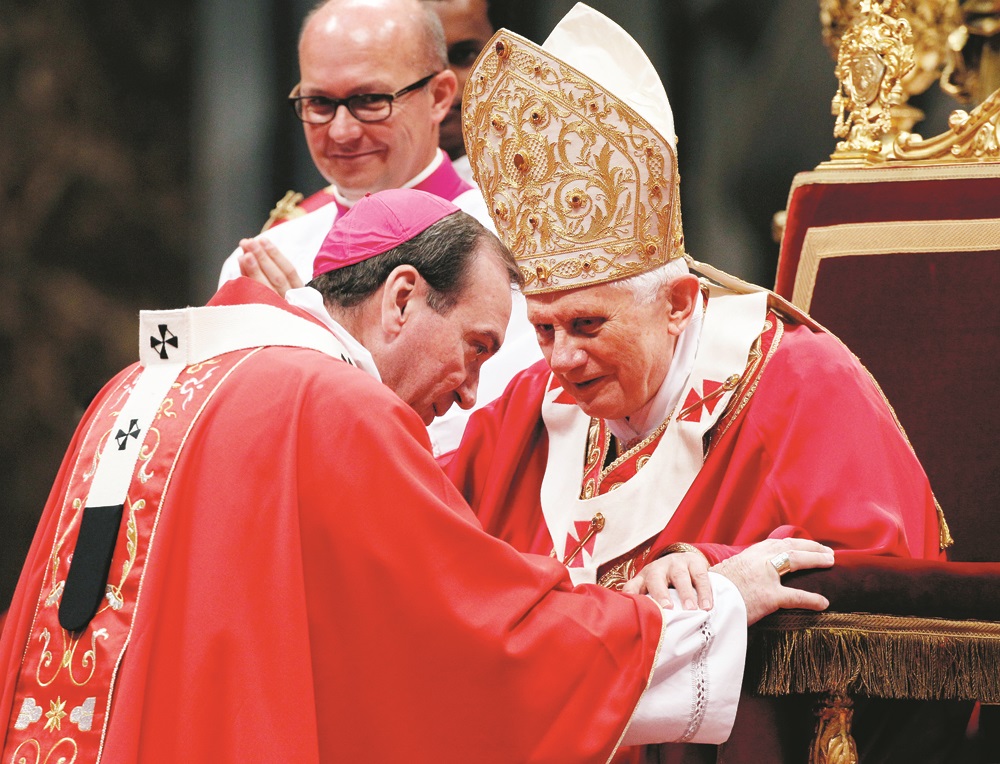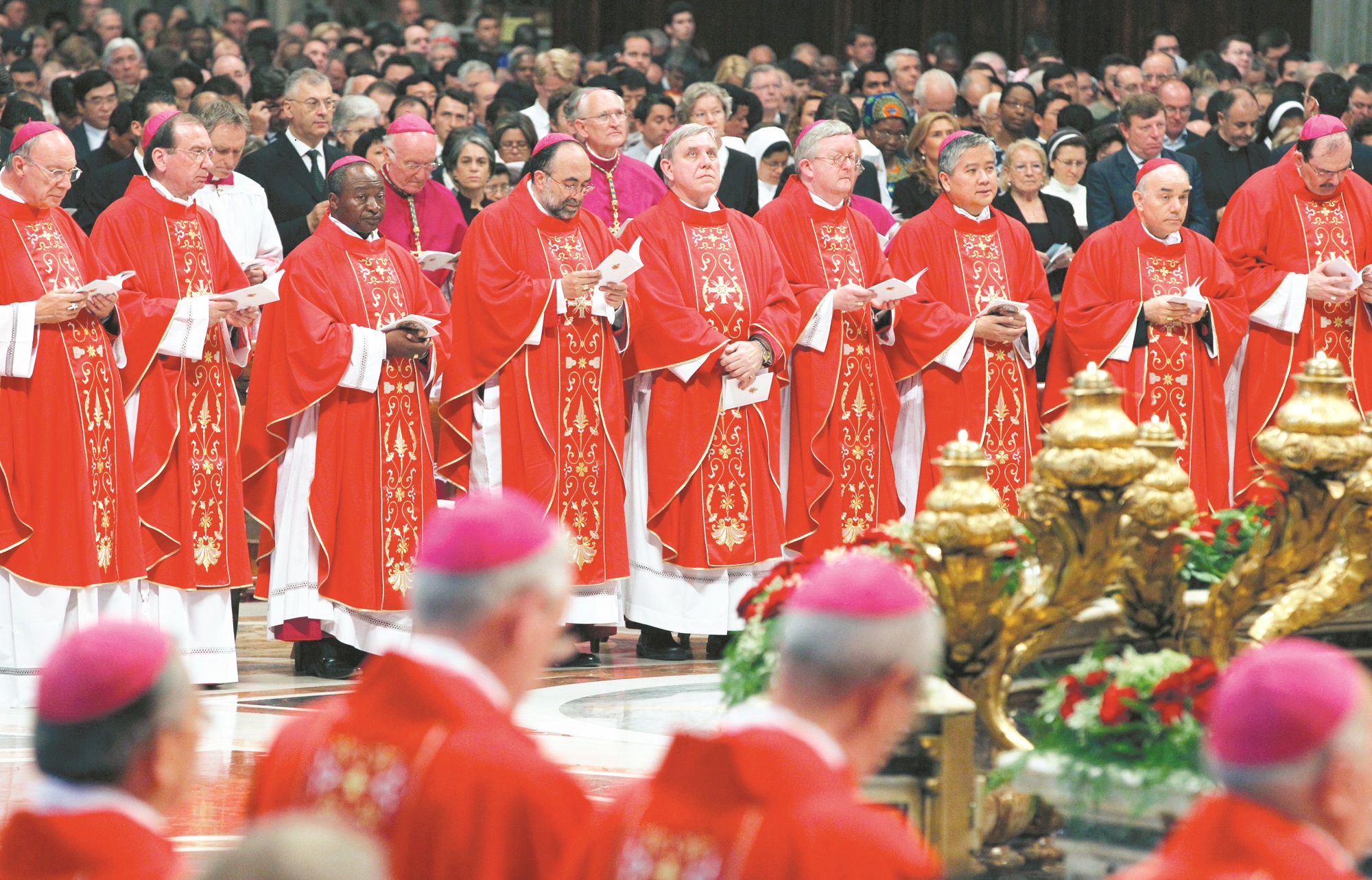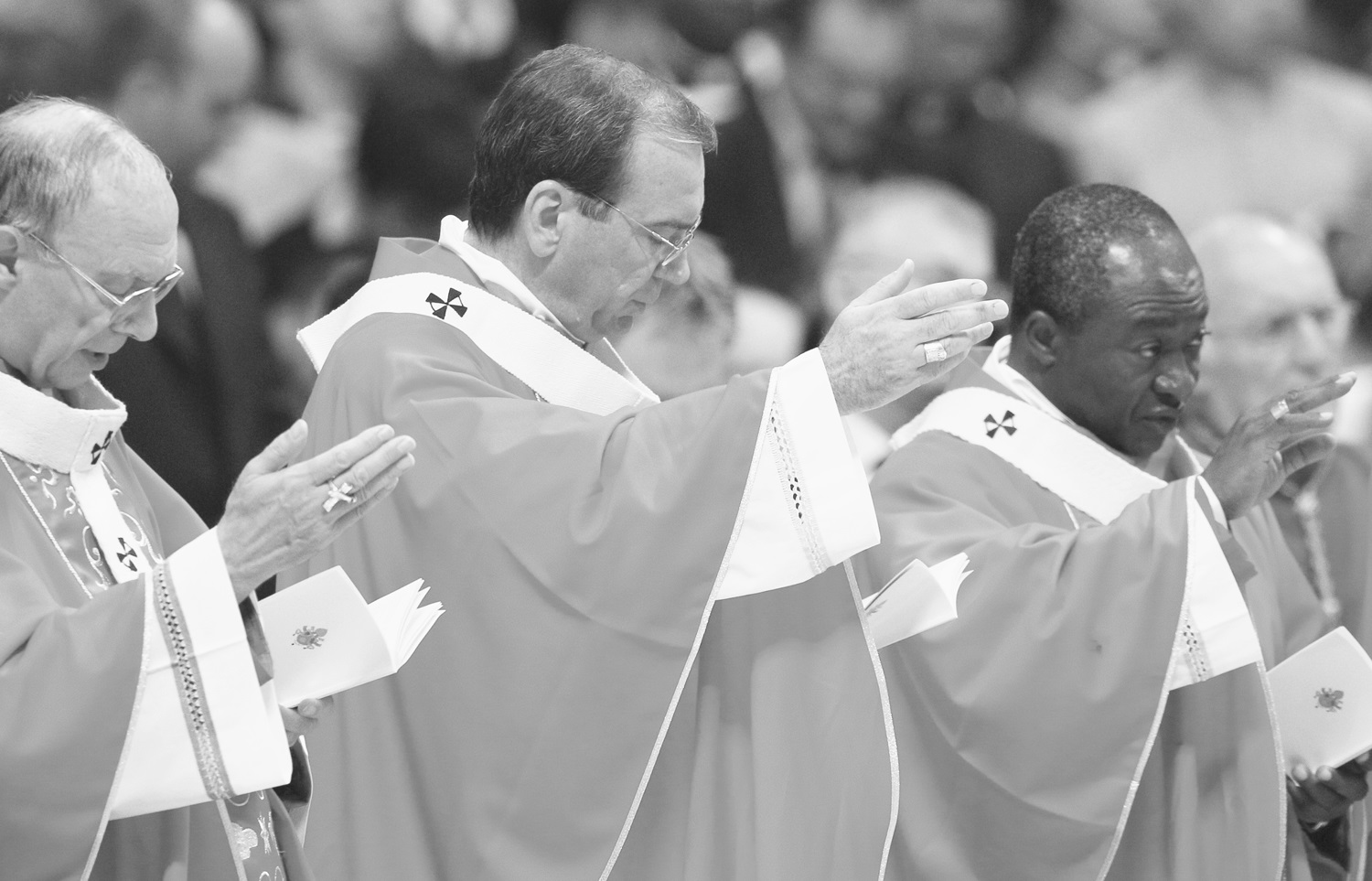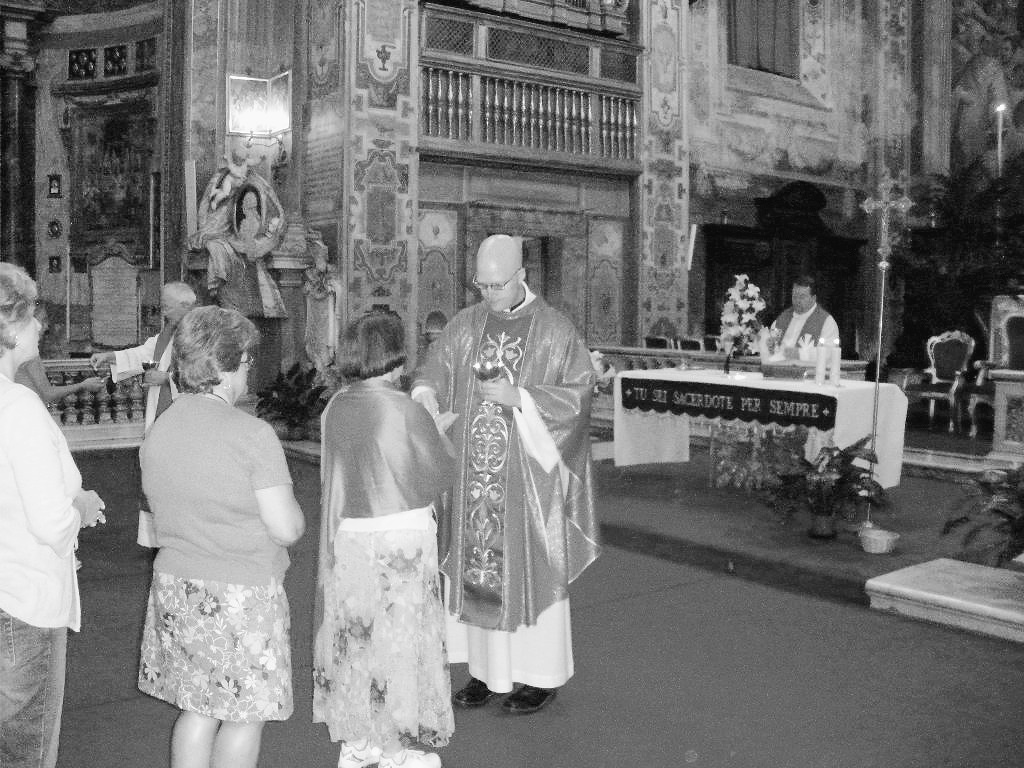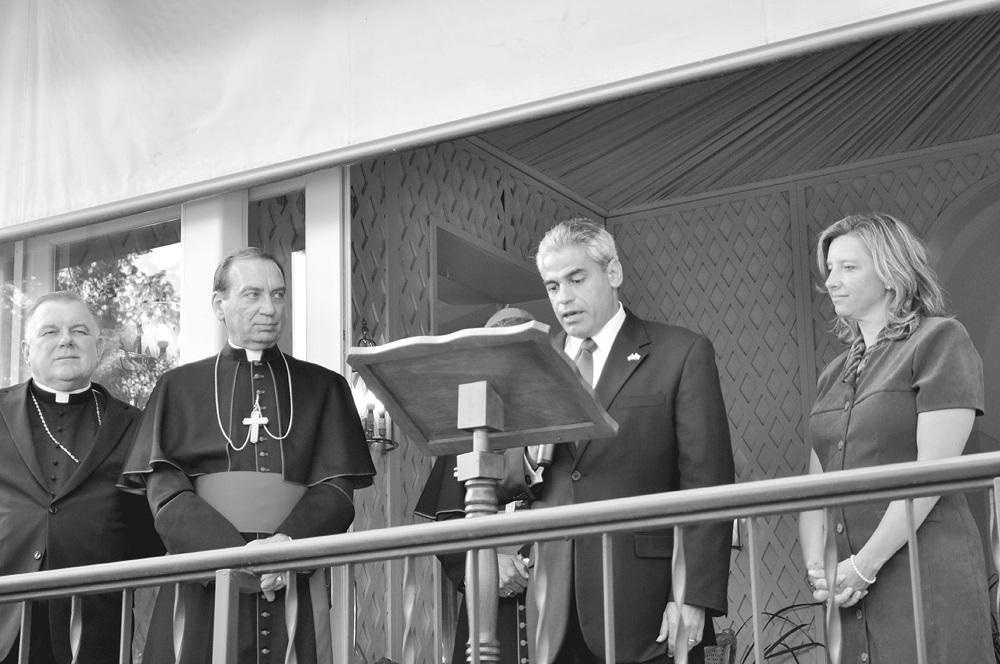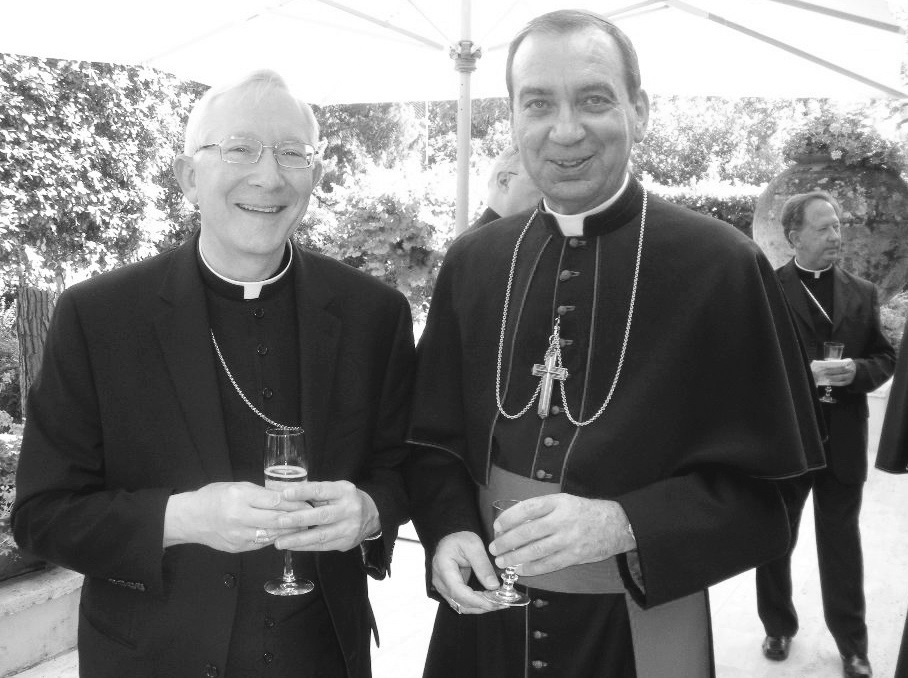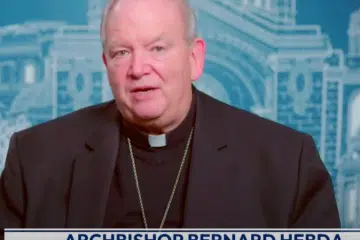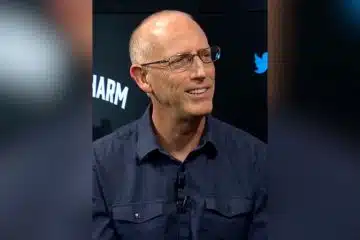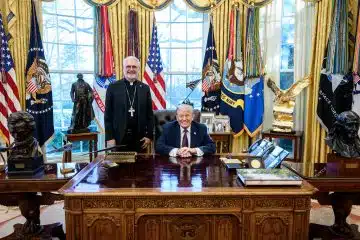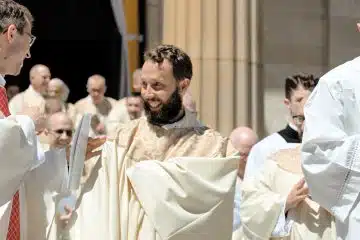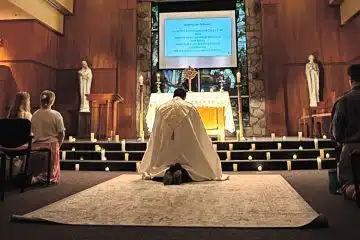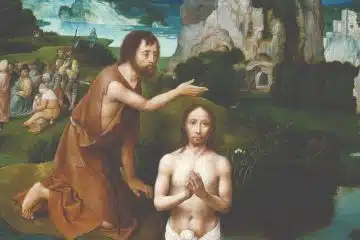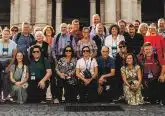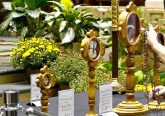Looking Back: Archbishop Schnurr receives pallium in Rome
VATICAN CITY — With more than 120 pilgrims from the Archdiocese of Cincinnati in attendance in St. Peter’s Basilica, Archbishop Dennis M. Schnurr received the pallium from Pope Benedict XVI June 29, the feast of Sts. Peter and Paul.
Placing a woolen band around the shoulders of 38 new archbishops from 26 different nations, Pope Benedict XVI told them it was a Gospel “yoke” — not a heavy burden, but a sign that by remaining united with the church in faith, they will have the strength to face whatever challenges come their way.
“Communion with Peter and his successors, in fact, is the guarantee of freedom for the pastors of the church and for the communities entrusted to them,” the pope said June 29 during his homily. The woolen pallium is a sign of their sharing with him authority over the faithful in their archdioceses, he told the archbishops.
Other archbishops from North America named in the past year included: Archbishops Jerome E. Listecki of Milwaukee; Thomas G. Wenski of Miami; and Albert LeGatt of Saint-Boniface, Manitoba.
The pilgrims included 14 members of Archbishop Schnurr’s family, as well as friends and former co-workers from the Diocese of Duluth, where he served as bishop before his appointment to Cincinnati in 2008.
In his homily, the pope said the church has faced persecution throughout history, but it suffers greater damage “from that which pollutes the faith and Christian life of its members and its communities, attacking the integrity of the mystical body, weakening its capacity for prophecy and witness, tarnishing the beauty of its face.”
Unity with the church and with the pope, he said, guarantees that “the local churches and bishops’ conferences have freedom in relation to local, national or international powers, which can, in some cases, block the church’s mission.”
But even more importantly, communion with the pope “is the guarantee of freedom in the sense of full adhesion to the truth, to the authentic tradition, so that the people of God are preserved from errors concerning faith and morals,” he said.
The pallium is the “yoke” Jesus spoke about; it does not weigh down the person carrying it, but supports him in his unity with the rest of the church, the pope said.
St. Peter’s was filled to near-overflow on a warm Rome day, and those in attendance watched the moving ceremony, which including the retrieval by the deacons of the Mass of the pallia from St. Peter’s tomb under the altar, where they had been placed the previous evening following vespers. Following the Mass, the pope also descended to the tomb of the first pope and prayed there for a few minutes.
In the presence of a delegation from the Ecumenical Orthodox Patriarchate of Constantinople, the pope said, “one of the typical effects of the action of the Evil One is division within the ecclesial community. Divisions, in fact, are symptoms of the force of sin.”
Thanking the Orthodox delegation for celebrating the feast with the Catholic community, the pope also said he was confident that a renewed faith in Jesus and continuing commitment to dialogue would bring unity one day.
Many in attendance remarked on the somewhat lengthy exchange that took place between the pope and Archbishop Schnurr just after the pallium was placed on the archbishop’s shoulders. The Holy Father inquired about Archbishop Daniel E. Pilarczyk, retired Archbishop of Cincinnati, and asked Archbishop Schnurr to give him the pope’s regards, Archbishop Schnurr later explained.
Following the Mass, Archbishop Schnurr met with attendees at a courtyard reception at the North American College, situated on a hill overlooking St. Peter’s Basilica. He said the pallium has taken on several meanings throughout history, but pastoral care for one’s archdiocese and an assurance of Christ’s presence are the two primary messages carried by the woolen band.
“The Holy Father, in placing the pallium around the shoulders of the new archbishops, is encouraging and telling the archbishops that they must carry their sheep,” he said. “The other symbol is that of the yoke; the duty of the office can be rather onerous at times, but we are to see the pallium and be reminded of the words of Christ, ‘Come to me all who labor and are weary for my yoke is light and my burden is easy,’” the archbishop said.
The busy pilgrims had a week in which they experienced spiritual and temporal treasures. Mass was celebrated at such sites as the Church of Sant’Anna, which is not open to the public, at St. John Lateran, at the Basilica of St. Mary Major; in Assisi at the Basilica of St. Francis, and at several other historic Rome churches.
Many in the group joined in the celebration of vespers at the magnificent St. Paul Outside the Walls on June 28, a Mass in which the pope announced the establishment of a new pontifical council for new evangelization to find ways “to repropose the perennial truth of the Gospel” in regions where secularism is smothering church practice. The announcement was met with applause and excited murmurs throughout the church.
Fathers Kyle Schnippel, Robert Hadden, Tony Cutcher, Joseph Robinson and Gerald Bensman took turns serving as principal celebrants or concelebrated with Archbishop Schnurr. The archbishop’s nephew, Thomas Schnurr, a seminarian for the Diocese of Lincoln in Nebraska, served as a lector. His uncle also took him shopping in Rome to purchase an alb for his ordination to the diaconate in 2011.
Archdiocesan pilgrims found time for sightseeing, touring the St. Peter’s Basilica and the tombs of the popes beneath it, including Pope John Paul II, where a crowd continues to gather in prayer continuously. The group visited the Vatican Museum and the Sistine Chapel, the Basilica of St. Clare and the monastery of San Damiano in Assisi, the Scala Santa, and the historic sites of ancient Rome, including the Roman Forum and the Colisseum.
Father Cutcher, in his homily at Mass in the Capella of St. Caterina in Assisi’s Basilica of St. Francis, reminded the group of the distinction between tourists who “capture the moment” and pilgrims “who attempt to enter into the reality of where we are.”
The U.S. Ambassador to the Vatican, Miguel Diaz, hosted a reception for Archbishop Schnurr at his residence on June 28. He told those in attendance that the three U.S. archbishops who would receive the pallium the following day “represent the best of that rich and finely woven tapestry that is the United States of America.
With several years’ experience teaching at University of Dayton and years of living and teaching in Minnesota, he told the group that he felt he could claim Midwestern roots in addition to celebrating his years in southern Florida, where Archbishop Wenski leads Miami’s Catholics.
On a serious note, he spoke of the ways in which his office and the Vatican can work on their shared mission: “Feed the hungry, heal the sick, and bring a message of hope to those who desperately need to hear it.”
He toasted Archbishops Schnurr and Wenski, both of whom were in attendance, saying, “May the yoke of the pallium always rest lightly on your shoulders.”
Many of the archdiocesan pilgrims also attended Pope Benedict XVI’s general audience on June 30, held in St. Peter’s Square. The pope offered greetings to the many special groups, particularly those who had traveled with their archbishops. The Cincinnati contingent offered a rousing cheer as Archbishop Schnurr’s name was announced, and the pope waved to the group.
Pope Benedict spoke about the role of pastor, saying a good pastor is one who knows and upholds the church’s moral teaching but also knows the worries and concerns of his people. He focused his remarks on the life and ministry of St. Joseph Cafasso, an Italian priest who died 150 years ago.
“He loved the Lord totally, was animated by a deeply rooted faith, sustained by profound and prolonged prayer and lived with sincere charity toward all,” the pope said about the Italian saint who was the spiritual director of St. John Bosco and the uncle of Blessed Giuseppe Allamano, founder of the Consolata Missionaries. St. Joseph Cafasso was a professor and later rector of an institute in Turin, which taught newly ordained priests moral theology and trained them to hear confessions and to preach.
“He knew moral theology, but he also knew the situations and the hearts of the people and took on their burdens like a good shepherd. Those who had the grace of being close to him also were transformed into good pastors and valid confessors,” the pope said.
Tricia Hempel and Cindy Wooden contributed to this story.
This article originally appeared in the July 9, 2010 edition of The Catholic Telegraph newspaper. For your complimentary copy of The Catholic Telegraph Magazine, click here.
